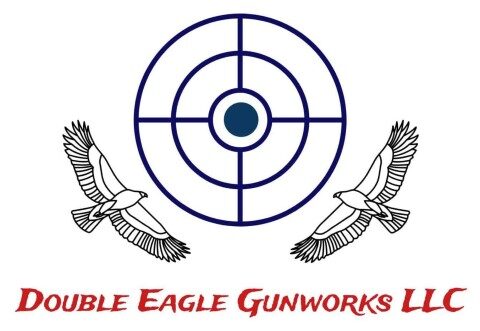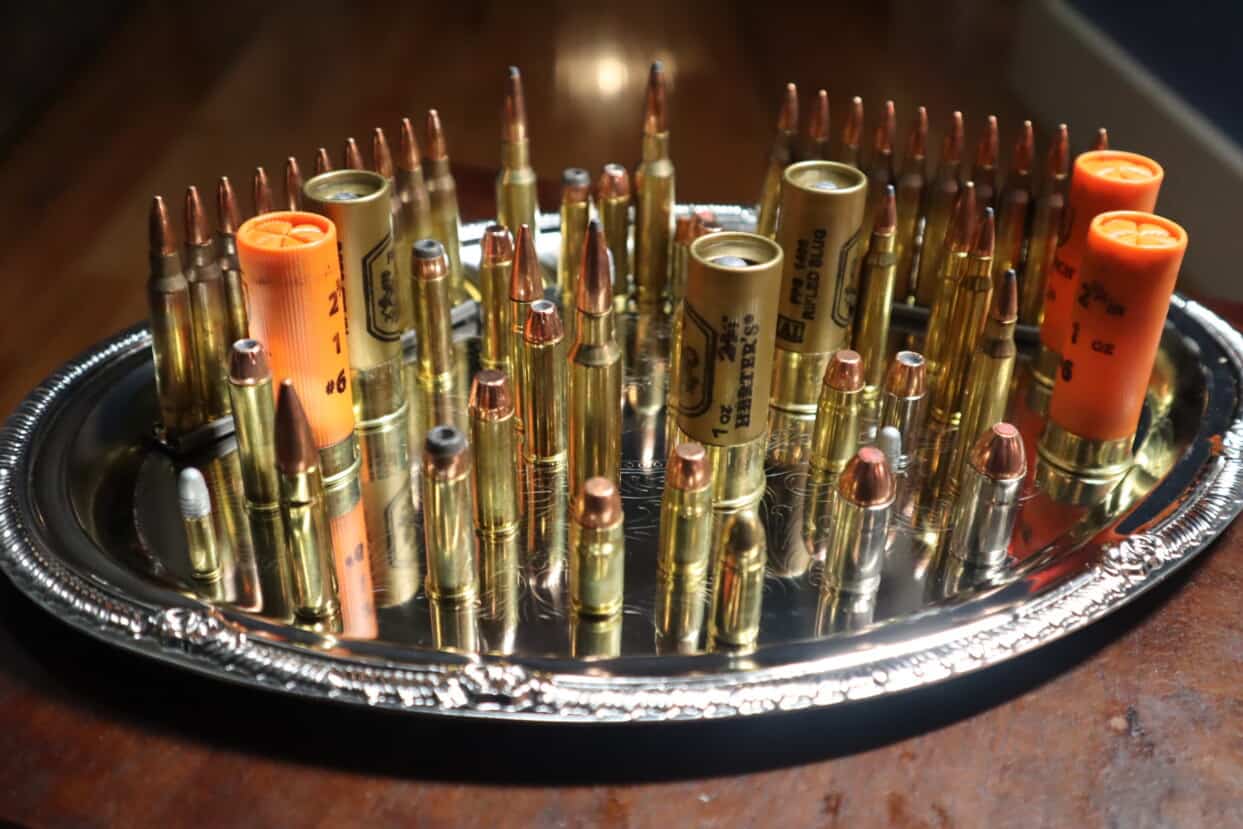When you shoot your gun, what is coming out of the barrel at high speed? If you are like me, you envision a single piece of hot lead that rams into something and then lodges there. Not so. A bullet is one component of the round that goes into the chamber of the gun.
The components of a cartridge, or round of ammunition, are the case, the primer, the powder, and the projectile.
The Case
If you look at a .38 Special cartridge, you see the nose of the assembly, which is the bullet. This is the part that exits the gun and heads toward your target. The rest of what you see is the case, which is retained in the revolver. With a semi-automatic round, the case is the part that is expelled after the shot. Cases can be straightwall or bottleneck in shape and rimmed or rimless at the bottom.
Straightwall
The body of the case is the middle segment and comes in straightwall or bottleneck styles. Most handgun rounds have straightwall cases, including .22LR, .38 Special, 9mm, .357 Magnum, .45ACP, and .40S&W calibers. Straightwall ammo has a case in the same width as the bullet.
Bottleneck
Most rifle cartridges are in a bottleneck case, including .223, 5.56, .300 Blackout, and 6.5 Creedmoor. Bottleneck ammo has a shoulder and a neck so that a bigger case filled with more powder can be fitted to a smaller bullet.
Rimless
The head of the case is the flat part at the bottom. It can be rimmed or rimless. Rimless cartridges don’t have an extra edge at the bottom, allowing them to drop down into the chamber of the gun without catching on anything. Rimless cartridges are usually for semi-automatic guns.
Rimmed
A rimmed case is usually for a revolver, so the rim of the case catches on the cylinder and does not go all the way through to the barrel. That’s how the case stays put as the bullet is ejected.
The Primer
When you pull the trigger on a gun, you engage a small part called the firing pin that strikes the bottom of the cartridge.
The dimple on the underside of the cartridge is the primer. The primer is the small powder charg in the base of the cartridge that causes the powder to ignite when hit by the firing pin. It does so by generating heat, which is transferred to the main propellant charge to ignite it.
The primer ignites the propellant. The gases expand because of the burning powder, forcing the bullet down the barrel. Primer comes in rimfire and centerfire varieties.
Rimfire
A .22 is a rimfire cartridge. Instead of having the primer in the center of the case, it is made into the rim of the case. The rim on the edge of the case is the primer. The firing pin strikes the edge of the case to set off the primer. The primer sets off the powder, which starts to burn and forces the bullet out of the gun.
Center Fire
The .38 Special is a center fire round because the primer is in the middle. When you squeeze the trigger, the firing pin on your revolver hits the primer, causing the powder in the primer to ignite.
The Powder
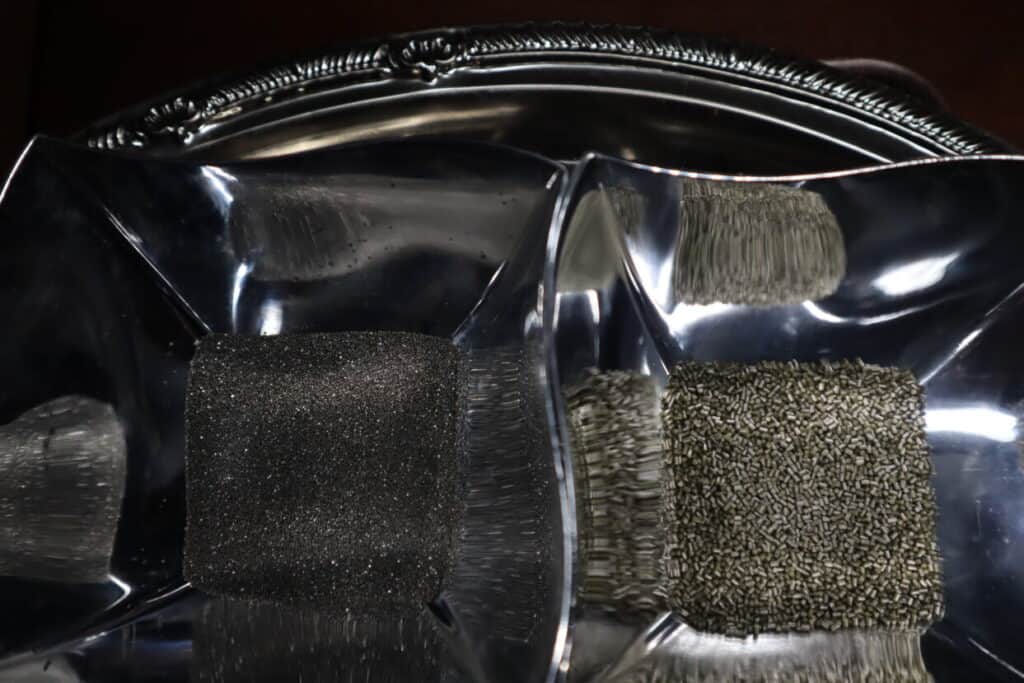
Inside the case you have the powder, which provides the boost to send the bullet on its way. The primer is the charge that sets off the powder. Guns originally used black powder, but now the usual formulations include smokeless powder.
Smokeless powder isn’t really smokeless but produces far less smoke than its predecessor. The combustion is gaseous. The expansion of the gases is what ultimately forces out the bullet.
Smokeless powder is not really a powder; it is pelletized or extruded granular material. Powder can be single-base or double base.
Single-base powder uses nitrocellulose as the only explosive propellant ingredient.
Double-base powder uses nitrocellulose with nitroglycerin or diethylene glycol dinitrate.
Powder can be spherical, cylindrical, or flaked. The configuration affects burn rate and how well each shape fits into the case. Shooters who reload their own ammunition will need to study the differences in great detail. Buying it off the shelf does not require knowledge of the powder’s shape.
The Projectile
This is where the variety occurs. The projectile is the bullet. It comes in a plethora of shapes, sizes, and materials. This is where you can get bogged down in the details.
Caliber
Your ammunition must match the caliber of the gun. Caliber means the size of the bullet. The smallest caliber is a .17HMR, which is a rimfire cartridge for a small rifle. Common calibers include .380, 9mm, .357 magnum, .38 special, .40S&W, and .45ACP. Even though this is a long list, you will find more varieties as you get deeper into the world of shooting.
Two numbers that look alike may not be the same size, and two different numbers might have matching diameters. For instance, .38 and .380 sound like the same caliber to a new shooter but they are not.
The .380 is smaller (.355 inch diameter) than a .38 Special (.357 inch diameter) and is used in semi-automatics rather than revolvers. The .380 is also shorter than the .38 Special and the case holds less powder.
The .357 Magnum, on the other hand, is the same size as the .38 Special. Both have a diameter of .357 inches but the case is longer in a .357 Magnum.
Bullet calibers will often include extra letters to give more information about the manufacturer or the history of the bullet. The S&W in .40S&W stands for Smith and Wesson because that is the company that developed the caliber. The ACP in .45ACP stands for Automatic Colt Pistol.
Bullets of the same diameter may be interchangeable, but often in only one direction. A .357 Magnum, for instance, can use .38 Special rounds, but a .38 Special cannot shoot .357 Magnum ammunition because the .357 Magnum will not fit in the chamber of the .38 Special revolver.
The NATO in .223/5.56NATO stands for North American Treaty Organization because it was standardized for use by NATO forces in 1980 in the Standardization Agreement (STANAG).
The metric calibers such as 9mm were developed in Europe and the American calibers are measured in inches.
Metric measurements are stated in a diameter x length format, e.g. 5.56 x 45mm is 5.56 mm wide and 45 mm long.
Shotgun shells are assigned a gauge, with lower numbers having a larger diameter.
The remainder of the calibers you will encounter are measured in inches. A .22LR and a .223 are similar in width at two-tenths of an inch, and the biggest caliber in handguns and long guns, .500, is half an inch in diameter.
The length of the case is another consideration entirely. The length is determined by the amount of powder you need in the case and the diameter of the barrel of the gun. The photo below shows the calibers smallest to largest, with some of the thinnest calibers having longer length because they are shot by rifles. A thin bullet can also have a fatter case, as demonstrated by the bottleneck cases below.
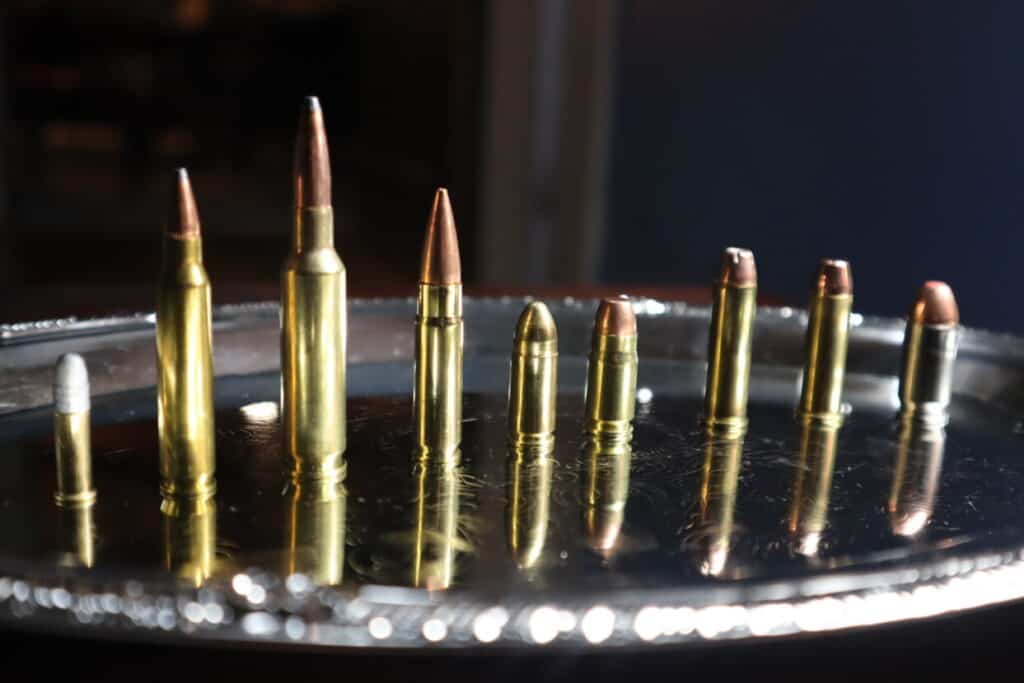
Handgun Calibers Smallest to Largest
.22 is about .223 inches in diameter. It is a small rimfire cartridge with a light recoil, suitable for plinking and varmint control. Variants include .22LR and .22 Winchester.
.380ACP is a centerfire handgun cartridge. Slightly smaller than a 9mm with a shorter case and less powder. Actual diameter .355 inch.
9mm/Luger/9x19Parabellum is the most common caliber of handgun. Now available in AR pistols, which are shorter barreled ARs.
.357 Magnum/.38 Special revolver rounds are both .357 inches in diameter but the .357 Magnum has more powder and therefore more kick. Variants include .38 Super. You can use a .38 Special in a .357 Magnum revolver, but don’t use .357 Magnum in a .38 Special revolver.
.357 Sig is one of the few bottlenecked cases used in pistols. It is a .40 caliber case necked down to 9mm. This increases the velocity of the bullet by allowing the manufacturer to add more powder.
.40S&W/10mm is a popular round for police duty. Also in 10mm Auto.
.44 Magnum is a big powerful revolver cartridge also used in some large semi-automatics and automatics. Actual diameter .429″/10.9 mm.
.45ACP is used semi-automatics. Lots of mass makes it hit the target hard. Also in .45GAP (Glock Auto Pistol) and .45 Long Colt. Shorter for a more compact gun. Actual diameter .451.”
.50/.500 is a large bore cartridge with hard recoil and a hard hit suitable for big game hunting. Also .50 Action Express, .50 Beowulf, and .500 Smith and Wesson Magnum. Actual diameter .510.”
Shotgun Shells Versus Slugs
Shotgun shells are a little different. They contain brass, propellant, over-powder wad, shot wad, shot pellets or slug, overshot wad, and top crimping. The brass base holds the primer.
The brass cap is the part of the shotshell that contains the primer.
Propellant is the powder, and comes in the same flakes, spheres, and cylinders used for rifle and handgun cartridges. Single base powders burn faster for high performance. Double base powders burn more slowly for use in heavier loads.
Wadding keeps the shot and powder from mixing and forms a seal to make sure the gas from the burning powder pushes the shot forward rather than blowing through it. Fiber wadding is biodegradable. Plastic wadding is another option.
Fiber wads must be compressed when they are placed in the case. Plastic wads have small parts that expand to create a seal in the bore of the barrel.
Shot is another option in shotguns. Instead of a single projectile like a bullet, shot is small pellets or balls that spread out when fired. Your chance of hitting a target increases when shooting at a moving target like a duck in flight.
Antimony is a metal that makes the shot harder when mixed with lead. This keeps the shot from deforming as it leaves the barrel. Game cartridges carry softer shot for a more humane kill. Shot pellets may be coated with copper or nickel to prevent the pellets from sticking to each other.
Slugs are single projectiles like the bullet in a rifle or handgun cartridge.
Sabot is a plastic cylinder around some shotgun slugs to add spin to the projectile.
Crimping the end of the shell folds it in to hold the shot, powder, and wad in the cartridge.
Rifling is spiral grooves cut into the projectile to increase rotation. Not to be used in a rifled barrel.
Gauge is the diameter of the shotgun barrel. The number refers to how many lead pellets of that diameter will add up to a weight of one pound. A bigger gauge is a smaller diameter. The most common size is 12 gauge, but you may also see 10, 16, 20, and 28 gauge.
Rifle Calibers Smallest to Largest
.223/5.56mm NATO (North Atlantic Treaty Organization) is useful for home defense and varmint control. Variants include .218 Bee, .223 Remington, .220 Swift. You can use .223 in a 5.56 gun, but don’t use 5.56 in a .223 gun because the 5.56 generates more pressure than the .223, and the .223 barrel is not designed to handle that much pressure.
.260/6.5mm is useful for long range competition and hunting. Variants include .260 Remington, 6.5 Creedmoor, and 6.5 Grendel.
.284/7mm is for hunting. Variants include .280 Remington, 7mm-08 Remington, and 7×55 Mauser.
.30/7.62mm is for hunting and military use. Variants include .308 Winchester, .30-30 Winchester, 7.62 x 51mm NATO, and .300 Blackout. You can use 7.62 in .308 guns, but don’t use .308 in 7.62 guns.
8mm Mauser is a rimless bottlenecked rifle cartridge.
5.45x39mm Soviet is a rimless bottlenecked rifle cartridge.
7.62x54mm Russian is a rimmed rifle cartridge that has been in use since it was introduced by the Russian Empire in 1891.
.50BMG (Browning Machine Gun) is a huge rifle cartridge used in machine guns as well as bolt action and semi-auto rifles. The bottleneck case makes a very big impact when used by the military as a long range sniper round or to stop vehicles.
Shapes and Constructions
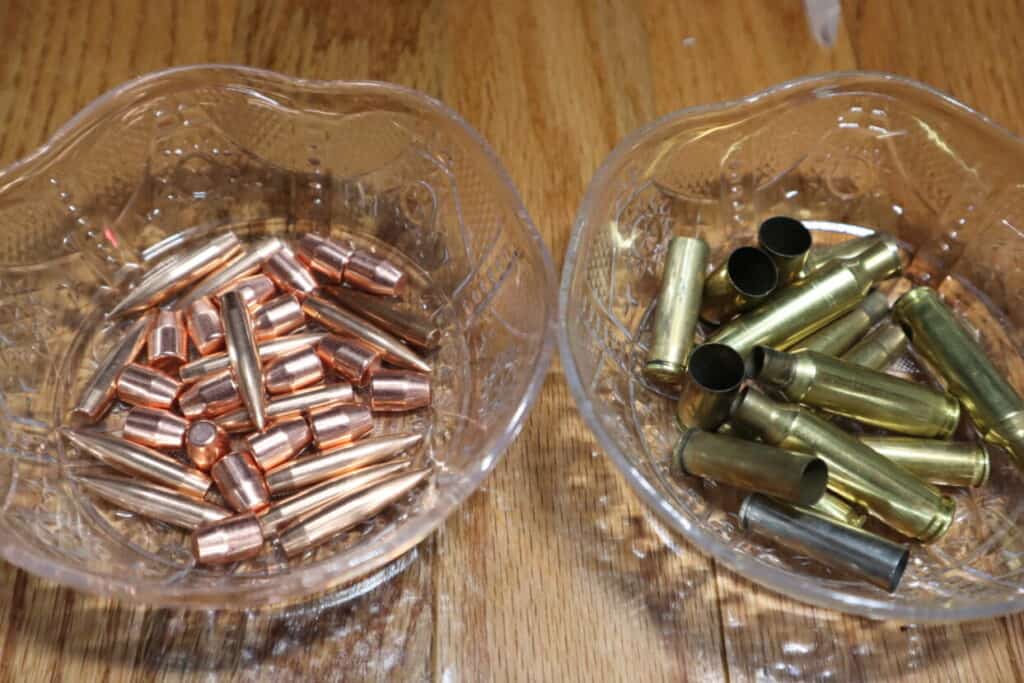
Bullets come in a variety of shapes, with varying levels of hard metal encasing the soft lead. Most bullets are made of lead or another soft metal and may be encased in a jacket of copper or another hard metal.
Pistol bullets are shorter and wider than rifle bullets. Longer bullets are more aerodynamic. More mass is more devastating at a shorter range.
Elongated shapes include the round nose, semi-round nose, Spitzer, and semi-Spitzer.
Flattened shapes include flat nose, wadcutter, semi-wadcutter, and pure lead.
The base configuration is the shaped of the bottom of the bullet. Common base configurations include flat, for most handguns and many hunting rifles; hemispherical for European hunting bullets, streamlined boat tail for low drag in long range hunting, and hollow or recessed for handguns to maximize bearing surface and gas sealing.
If the bottom of the bullet is flat, it pushes the gases sideways. A slight recess in the bottom keeps the gases under the bullet, where they can most effectively push it out.
Armor Piercing (AP) for rifle and handgun cartridges is only for the police and military. It has a hardened penetrator to penetrate ballistic armor. The velocity on these bullets is high enough to catch dry grass on fire. AP is illegal for civilians.
Ballistic/Polymer Tip for rifle and single-shot handguns is a hollow point with a polymer (hard plastic) tip molded into an aerodynamic shape. This improves expansion upon impact for high lethality against big game animals.
Boat Tail (BT) for rifles has a curved bottom that decreases air turbulence for long range shooting.
Boat Tail Hollow Point (BTHP) is primarily for rifles to shoot big game like moose and hogs at long ranges. The hole in the middle causes the bullet to expand rapidly on impact and the tapered tail increases accuracy.
Bonded bullets are used by big game hunters. The core is bonded to the jacket for controlled expansion when hunting elk or bear.
Capped bullets have a soft metal cap over the soft point that collapses on impact to aid expansion. The Winchester Silvertip is an example of this uncommon bullet.
Frangible bullets are usually lead free and made of composite materials designed to break into small pieces on impact with a hard surface. These are useful for self defense.
Full Metal Jacket (FMJ) is a military round for handguns and rifles used for practice, training, and qualification. Sometimes used in competition and hunting. You may hear it called ball ammo. Practice with a full metal jacket because it is less expensive. The entire bullet is covered with a piece of metal, typically copper.
Hollow Point (HP), or Recessed, has a metal jacket but has a hole in the center to allow expansion when it hits the target. Your defensive load for your carry handgun should be a hollow point. Also for lightweight, small caliber rifle bullets for varmint hunting. The hollow point is the lipstick-shaped bullet that you are most likely to see in a picture.
Hollow Soft Point is a revolver bullet with a hollow in the center and a soft inner core for expansion on impact.
Hybrid bullets combine any of the types listed here.
Jacketed Hollow Point (JHP) has a jacket of hard metal around some or all of a soft inner core.
+P overpressure bullets are loaded to a higher internal pressure and should only be used in firearms designated for +P. The higher pressures increases velocity and kick.
Round Nose is a less aerodynamic shape with a harder hit for hunting. The round nose can be used in revolvers or semi-automatics.
Semi-Jacketed bullets have soft lead only partially encased by a harder metal. Generally, revolver bullets are semi-jacketed, and semi-automatic bullets are jacketed.
The Semi-Wadcutter is also known as a Truncated Cone because it is cone shaped. It feeds better in a semi-automatic than a wadcutter.
Semi-Jacketed Hollow Point has more penetration than a regular hollow point because the partial jacketing of harder metal makes a more uniform and predictable expansion on impact. Good for self defense with a revolver.
Soft Point (SP) has a soft inner core for expansion on impact and is used for hunting.
Solid bullets are one piece of metal or a heavily jacketed lead core, or a hybrid of the two. These are used to penetrate reliably into heavy or dangerous game.
Spitzer has a fine point at the tip for increased accuracy.
Tipped bullets have a metal or plastic tip on the ogive (the roundly tapered end) to prevent tip deformation in magazines, enhance aerodynamics, and assist with expansion on impact.
Very Low Drag (VLD) has a Spitzer tip covering a hollow cavity with a boat tail base. It shoots flatter, with less wind drift, and retains more of its velocity.
Wadcutter is a short range flat nosed bullet designed for revolvers. Its shape will not feed in a semi-automatic. It makes a nice clean hole in a paper target.
Grains: a Measure of Weight
When you look at a package of ammunition and it specifies the grains of the cartridge, often written as “gr,” that tells you how heavy it is. A pound is 7,000 grains. An ounce is 437.5 grains.
The weight of the ammunition has an effect on recoil, trajectory, and the impact of the bullet on the target. For casual target shooting, called “plinking,” weight does not make a significant difference.
Characteristics of lighter weight ammunition
- faster
- straighter trajectory over a longer distance.
- reduced recoil
- higher muzzle velocity
- less kick
- less expensive
Characteristics of heavier ammunition
- less subject to windspeed affecting accuracy
- greater expansion and penetration when it hits the target.
- longer to increase aerodynamics.
- added mass increases momentum.
- decreased muzzle velocity
- more recoil
- less room for powder
Loading the Ammunition
One big difference between the types of ammunition is how they are loaded. Semi-automatic cartridges are loaded into a magazine that is inserted into the magazine well in the grip of the gun.
You rack the slide to get the first bullet in the chamber. When you shoot it, the bullet is forced out the front toward your target and the case is ejected sideways.
Revolver cartridges are loaded into individual chambers in a cylinder that rotates into place with each shot.
Rifles can be bolt action, lever action, pump action, or semi-automatic. Bolt action and semi-automatic rifles have external magazines inserted into the receiver. Lever action and pump action generally have tubular magazines that are integral to the gun.
Shotguns are loaded from underneath into a tubular magazine.
Putting It All Together: How to read the specifications on a box of ammunition
Walking down the ammunition aisle of a sporting goods store can be a dizzying experience. All those letters and numbers tell you about the shape, size, weight, performance and intended use of what you are buying. Let’s practice with these three:

1.HERTER’S SELECT FIELD RIFLED SLUG, 10 SHOTSHELLS, 12 GAUGE|2 3/4″ 1 OZ, VELOCITY-1400 FPS
2. American Eagle, 90 ROUND PACK CLIPPED CENTERFIRE RIFLE CARTRIDGES, 5.56 x 45mm NATO, 55 GRAIN FMJ CLIPPED, MUZ VEL 3165 FPS, XM193AF90
3. SIG SAUER, ELITE PERFORMANCE AMMUNITION, SIG V-Crown, 20 Jacketed Hollow Point, Centerfire Pistol Cartridges, Mzl 1165 ft/sec 443 ft-lbs, 9mm LUGER 124 gr
Brand Name
When you look on the end of a box of rounds you will see the brand name of the maker in big bold letters: Herter’s Select Field, American Eagle, Sig Sauer Elite Performance Ammunition. XM193AF90 is an item number.
Purpose and Quantity
A rifled slug is a shotgun projectile with spiraled grooves (rifling) cut into it to make the slug spin as it exits the barrel for stability. Shotguns can be loaded with shot, little pellets that spread out when fired, or a slug, which is basically a bullet. Slugs hit the target with more force than shot. Box #1 comes with 10 shells.
Box #2 contains 90 rounds of clipped centerfire rifle cartridges. They are clipped together in rows of 10 on stripper clips, speedloaders that allow the user to load all ten rounds at the same time by stripping them off the clip. Centerfire refers to the position of the primer in the middle of the cartridge.
Box #3 contains 20 centerfire pistol cartridges.
Caliber, Weight, and Velocity
Box #1 contains 12 gauge shotgun shells, with a length of 2 3/4″ and a weight of one ounce each. The muzzle velocity is 1400 feet per second.
Box #2 contains cartridges that are 5.56 mm in diameter and 55 grains in weight. There are 437.5 grains in an ounce. The muzzle velocity is 3,165 feet per second.
Box #3 contains 9mm Luger cartridges with a weight of 124 grains. The muzzle velocity is 1,165 feet per second. Muzzle energy is measured in foot-pounds. Sig V-Crown describes the shape of the ammunition.
Use
Box #1 is for a shotgun. Shotguns are known for their stopping power at short range. They are also used for skeet shooting, trap shooting, and clay pigeons. Shotguns make effective lethal wounds for hunting.
Box #2 is used with a rifle for varmint control and home defense.
Box #3 is for home defense and varmint control with your semi-automatic pistol.
Next time you visit the gun shop, look around at all the different kinds of ammunition available. It’s an amazing world of choices. It will make more sense when you have chosen a gun and learned which ammunition goes with that gun.
